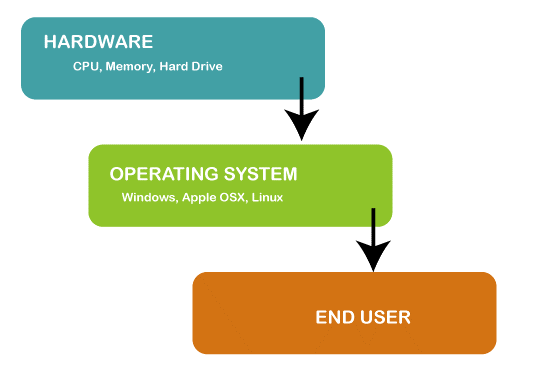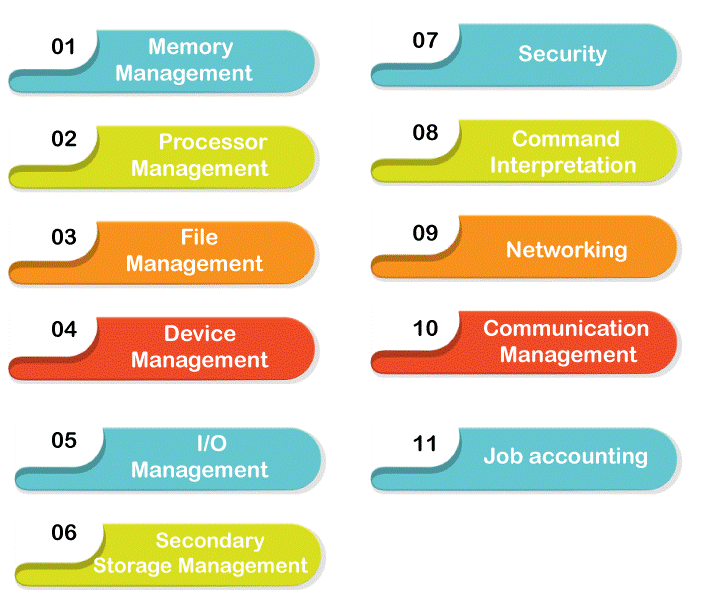5 Goals of Operating System
An Operating System (OS) is system software that acts as an interface or bridge between the hardware of a computer and the end user.
Operating System reduces the communication barrier between the user and the system and helps the user to communicate easily with the computer.
Every computer system requires an operating system to run its applications and programs. Applications like Browsers, MS Office, Notepad, Games, and many more require some space or can be an atmosphere to perform their tasks.
This operating system is an essential need or requirement of a system such as a laptop, computer, iPad, mobile phone, etc. With OS, the user can communicate and perform any task on the system.

Examples of Operating Systems
There are various types of operating systems which are available in the market:
- Windows
- Android
- iOS
- Mac OS
- Linux
- Chrome OS
- Windows Phone OS
Goals of Operating System
There are mainly 2 goals of the operating system:
- Convenience
- Efficiency
The other 3 goals are:
- Portability and Reliability
- Hardware Abstraction
- Security
1. Convenience
An Operating System's primary and first goal is to provide a friendly and convenient environment to the user. It is optional to use Operating System. Still, things become harder when the user has to perform all the process scheduling and convert user commands to machine language so that system can perform tasks. So, we use an Operating System to act as a bridge between us and the computer hardware. We only have to give commands to the system, and OS will take the instructions and do the rest of the work. Because of this operating system should be convenient to use and operate by the user.
2. Efficiency
The second and important goal of an Operating System is efficiency. An operating system should utilize all the resources efficiently. The management of resources and programs should be done so that no resource is kept idle and memory is used for no use.
3. Portability and Reliability
The operating system can work/operate on different machines with different processors and memory configurations. This makes the operating system more reliable.
Also, the operating system can protect itself and the user from accidental damage from the user program.
4. Hardware Abstraction
The operating system can conceal or can be said to control all functions and resources of the computer. The user can give commands and access any function or resource of the computer without facing any difficulties. In this way, the Operating system communicates between the user and computer hardware.
5. Security
An operating system provides the safety and security of data between the user and the hardware. OS enables multiple users to securely share a computer(system), including files, processes, memory, and device separately.
Functions of the Operating System

To achieve the goals of an Operating system, the Operating System performs several functionalities, which are:
- Process Management: The CPU executes many instructions for users at a time. Besides, user's commands, the CPU has some of its activities to perform, called processes. CPU has to complete all the tasks assigned to it. So, it solves the problem by giving a certain amount of time to a particular task. The operating system's function is to create and delete both user and system processes that are being executed or do not need to execute them.
- Memory Management: Various tasks and commands fetched by the CPU are stored in the memory for execution. The operating system keeps track of which part of the memory is currently being used. Allocating and de-allocating the memory as per need. And decides which process should be loaded in the memory when it is available.
- I/O Device Management: Various I/O devices are present in a system. Only OS has access to these devices. So, the Operating System must allow the use of I/O devices by the various processes requiring these resources.
- File Management: There are various files, folders, and directory systems in a particular computer. Computers can store the files in magnetic tape, hard disk, local folder, etc. The operating system manages all these. The function of the OS is to create and delete files and folders. Mapping of files and directories to the disk. Backing up data to non-volatile memory.
- Virtual Memory: Operating system loads some of the files, programs, and applications that are larger than the main memory in a memory which is called virtual memory.
- Job Accounting: Job Accounting is a system available in the operating system that helps track system resource usage. It keeps track of the time and resources used by various processes and users.